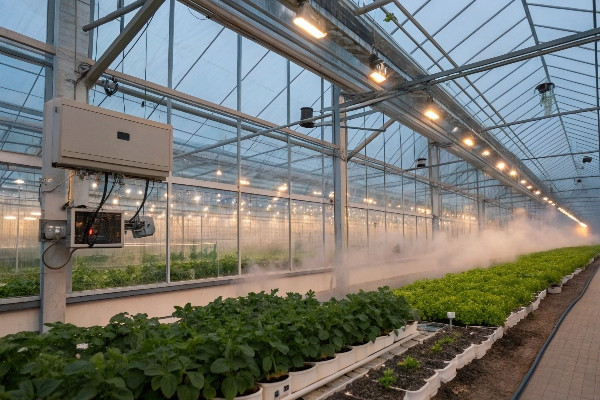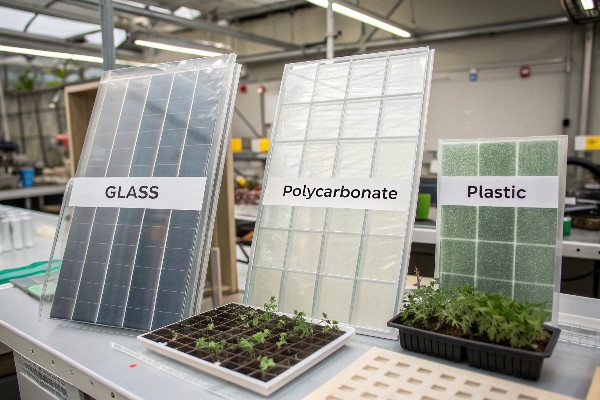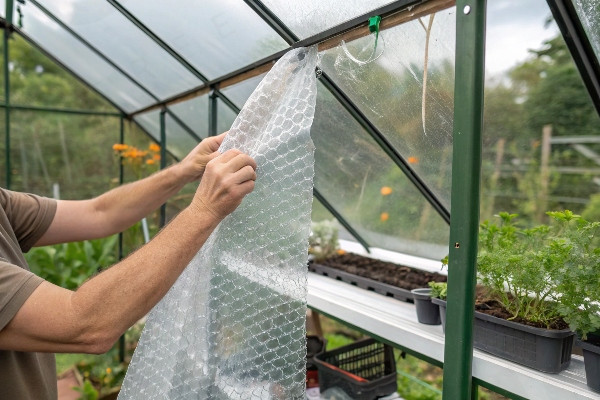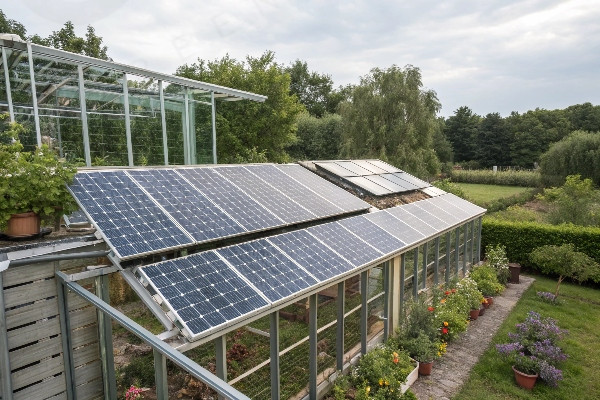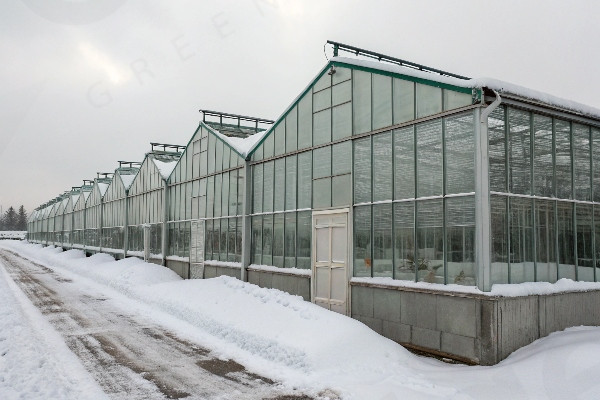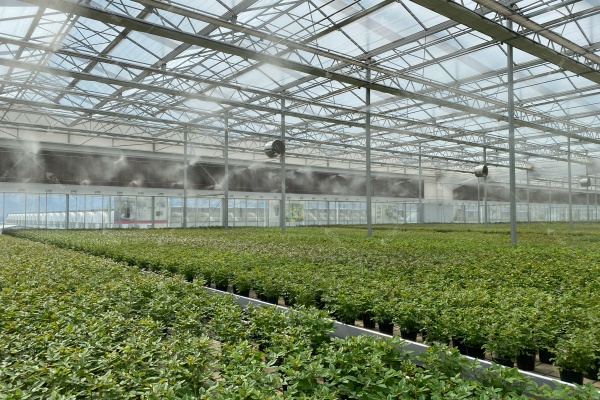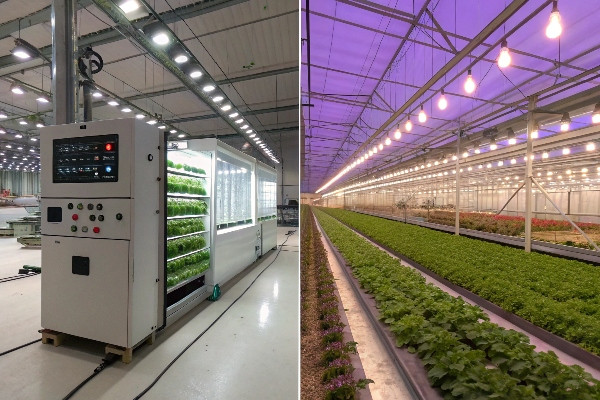Winter threatens to derail your growing season with plummeting temperatures and skyrocketing heating costs. Insufficient heating can destroy months of work overnight, while excessive energy use drains your budget. Finding the right heating solution is critical for winter growing success.
Effective greenhouse heating combines proper insulation with efficient heating systems tailored to your climate and budget. From simple DIY solutions to advanced smart systems, this comprehensive guide covers all aspects of keeping your greenhouse productive through the coldest months while minimizing energy consumption.
As a greenhouse specialist with nearly three decades of experience at CFGET, I’ve seen countless growers struggle with winter temperature management. Just last year, I visited a client in Northern Europe who had lost an entire crop of specialty herbs due to a heating system failure during a cold snap. The financial impact was devastating, but even more heartbreaking was watching years of careful plant selection and breeding disappear overnight. This experience reinforced my belief that understanding greenhouse heating isn’t just about technical specifications—it’s about protecting your investment, passion, and livelihood. In this guide, I’ll share practical knowledge gathered from working with greenhouses across vastly different climates, from commercial operations to hobby setups, helping you navigate the complexities of winter greenhouse heating.
Don’t Miss:——Exploring Greenhouse Types: Finding the Perfect Structure for Your Needs
You might like:——Mastering Strawberry Greenhouse Cultivation: Best Practices for Optimal Growth?
How Can You Choose the Right Greenhouse Covering Materials for Maximum Insulation Without Sacrificing Light?
Many growers struggle with covering materials that either leak heat excessively or block too much precious winter sunlight. Cold frames crack in extreme temperatures while plastic films tear and lose effectiveness after a single season. Poor covering choices lead to wasted energy and stunted plant growth.
The ideal greenhouse covering balances high insulation value with optimal light transmission properties. Modern materials like twin-wall polycarbonate, bubble insulation, and specialized greenhouse films deliver excellent thermal retention while allowing sufficient PAR light for plant growth even during short winter days.
Winter greenhouse covering selection requires understanding the critical relationship between thermal efficiency and light transmission. When I consult with clients facing extreme temperature fluctuations, I emphasize that covering materials represent their first and most important defense against cold. The science behind greenhouse covering effectiveness goes far beyond simple R-values and requires consideration of multiple performance factors that directly impact both plant health and heating costs.
Through years of field testing across diverse climate zones, I’ve developed a framework for evaluating covering options based on their real-world performance. Each material presents unique advantages and limitations that must be matched to specific growing situations and budgets. This systematic approach prevents costly mistakes and ensures optimal growing conditions throughout winter.
Comprehensive Greenhouse Covering Comparison
| Covering Material | Light Transmission (%) | Insulation Value (R) | Durability (Years) | Cost Rating | Best Applications |
|---|---|---|---|---|---|
| Single-layer glass | 90-95 | 0.9-1.0 | 25+ | $$$$$ | Permanent structures, ornamental displays |
| Tempered double glass | 80-85 | 1.5-2.0 | 25+ | $$$$$ | High-end growing, cold climates |
| Twin-wall polycarbonate | 75-82 | 1.5-2.0 | 10-15 | $$$$ | Commercial growing, moderate climates |
| Triple-wall polycarbonate | 68-75 | 2.0-3.0 | 10-15 | $$$$$ | Extreme cold regions, energy efficiency focus |
| Double polyethylene film | 80-85 | 1.2-1.4 | 3-5 | $$ | Budget operations, mild winters |
| IR-modified polyethylene | 82-87 | 1.4-1.6 | 3-5 | $$$ | Commercial operations with mixed crops |
| Acrylic panels | 85-92 | 1.3-1.8 | 10-20 | $$$$ | Premium permanent structures |
When implementing these materials in the field, the installation method significantly impacts performance. During a recent project in Sweden, we discovered that proper sealing and connection systems for twin-wall polycarbonate increased effective insulation by nearly 35% compared to standard installation practices. This attention to installation detail often makes a more substantial difference than the base material specifications themselves.
Light quality considerations become particularly crucial during winter months when day length and light intensity naturally decrease. Certain covering materials can filter out specific light wavelengths essential for plant development. For example, when working with a tomato producer in Finland, we found that switching from standard polyethylene to a specialized horticultural film increased winter fruit production by 22% despite identical thermal properties, due solely to improved light spectrum transmission.
I’ve also observed that covering material selection must account for local climate peculiarities beyond just minimum temperatures. When installing greenhouses in areas with heavy snow loads, the structural implications of covering materials become paramount. Rigid materials like polycarbonate panels may offer excellent insulation but require more robust framing to support snow accumulation, while flexible film systems allow snow to slide off more easily but may need replacement more frequently.
Last winter, I worked with a mountain herb grower who faced particular challenges with extreme temperature fluctuations rather than just consistent cold. Their location experienced sunny 10°C days immediately followed by -15°C nights. In this case, we implemented a hybrid covering system that combined the thermal stability of polycarbonate walls with a specialized IR-blocking roof film, resulting in 40% less temperature fluctuation and 28% reduced heating costs.
What Are the Most Effective Low-Cost Greenhouse Insulation Solutions for Budget-Conscious Growers?
Heating costs can quickly become unsustainable for small-scale and hobby greenhouse growers. Many abandon winter growing entirely due to prohibitive energy expenses. Even with heating systems running constantly, poorly insulated greenhouses leak heat and waste money.
Affordable insulation solutions like bubble wrap, thermal curtains, perimeter insulation, and heat sinks can dramatically improve greenhouse thermal efficiency without major investment. Strategic application of these techniques can reduce heating costs by 30-60% while maintaining suitable growing temperatures.
The economics of greenhouse heating presents a significant challenge for smaller operations and hobby growers. Through my work with community garden projects and small farms across different regions, I’ve developed practical approaches to thermal efficiency that don’t require specialist materials or technical expertise. These accessible methods focus on addressing the primary heat loss pathways that exist in most basic greenhouse structures.
Heat energy in greenhouses follows predictable physical laws, escaping through conduction, convection, and radiation. By systematically addressing each pathway, even modest investments in insulation can yield impressive results. I remember helping a community garden in Minnesota implement these techniques with materials costing less than $300, resulting in a winter temperature increase of 8-12°C without additional heating—sufficient to extend their greens production through most of the winter.
Budget-Friendly Insulation Techniques and Their Impact
| Insulation Method | Materials Cost | Installation Difficulty | Heat Retention Improvement | Durability | Light Impact |
|---|---|---|---|---|---|
| Bubble wrap interior lining | $ | Easy | 15-25% | 1-2 seasons | Moderate reduction |
| Water barrel heat sinks | $ | Easy | 10-30% | 3-5+ years | None |
| Trench perimeter insulation | $ | Moderate | 10-20% | 5+ years | None |
| Straw bale foundation wrap | $ | Easy | 15-25% | 1 season | None |
| DIY thermal curtains | $$ | Moderate | 20-40% | 3-5 years | Significant when deployed |
| Recycled carpet perimeter | $ | Easy | 10-15% | 2-3 years | None |
| Foam board north wall | $$ | Easy | 15-30% | 5+ years | North side only |
| Heat retention row covers | $ | Easy | 5-10% (plant level) | 2-3 seasons | Moderate |
During a particularly challenging project in rural Mongolia, where commercial materials were unavailable and temperatures regularly dropped below -30°C, we helped local growers implement a layered insulation approach. They used locally-available materials including felted wool, straw, and repurposed windows to create surprisingly effective season extension structures. The key insight was the creation of multiple dead air spaces—the same principle used in expensive commercial insulation but achieved through creative material use.
Beyond material selection, installation timing significantly impacts effectiveness for seasonal insulation methods. When working with small-scale growers in the northeastern United States, I developed a phased insulation schedule that aligned with seasonal temperature changes. This approach begins with perimeter insulation in early fall, followed by north wall insulation, and finally adding bubble wrap and thermal curtains as temperatures drop. This sequential method balances light availability against insulation needs throughout the changing season.
I’ve found that combining passive heat storage with insulation creates synergistic benefits that exceed the sum of the individual techniques. During a workshop in Washington state, we implemented a system using recycled 55-gallon drums filled with water and painted black, positioned to receive direct sunlight along the north wall of a greenhouse. This simple addition, when combined with basic insulation techniques, extended the frost-free period by nearly six weeks compared to insulation alone.
One often-overlooked aspect of budget insulation is the management of soil temperature. Working with an urban agriculture project in Chicago, we demonstrated that simple cold frames inside an insulated greenhouse, combined with insulation extending 18 inches into the soil around the perimeter, maintained soil temperatures above 7°C even when air temperatures inside the unheated greenhouse occasionally dropped below freezing. This soil warmth protected root systems and allowed continued growth during cold periods.
How Are Advanced Heating Technologies Revolutionizing Winter Greenhouse Production?
Traditional heating systems waste substantial energy heating air that quickly escapes through greenhouse coverings. Fossil fuel dependence creates vulnerability to price fluctuations and supply disruptions. The environmental impact of conventional greenhouse heating contradicts sustainability goals.
Advanced heating technologies like heat recovery systems, geothermal installations, and integrated renewable energy solutions are transforming winter greenhouse production. These systems can reduce energy consumption by 40-80% while providing more consistent plant-zone temperatures and reducing carbon footprints.
The evolution of greenhouse heating technology represents one of the most significant advancements in controlled environment agriculture over the past decade. Having overseen the implementation of various heating systems across diverse climate zones, I’ve witnessed firsthand how these innovations are reshaping the economics and sustainability of winter production. The shift from heating entire air volumes to targeted root zone and plant environment heating marks a fundamental paradigm change in approach.
While consulting for a large tomato producer in Canada facing extreme heating costs, we implemented a comprehensive heat recovery system that captured warm, humid air near the greenhouse ceiling and transferred that energy to incoming fresh air through a specialized exchanger. This seemingly simple modification reduced their natural gas consumption by 42% while simultaneously improving plant health by moderating humidity fluctuations. The initial investment was recovered in just 16 months of operation.
Advanced Heating Technology Comparison
| Heating Technology | Energy Efficiency | Installation Cost | Operational Cost | Environmental Impact | Best Applications |
|---|---|---|---|---|---|
| Heat recovery systems | Very High | $$$ | $ | Minimal | Large commercial operations |
| Ground-source geothermal | Excellent | $$$$$ | $ | Very Low | Permanent installations, cold climates |
| Water-source geothermal | Excellent | $$$$ | $ | Very Low | Locations with accessible water bodies |
| Hydronic floor heating | High | $$$$ | $$ | Low-Moderate | Long-season crops, propagation |
| Infrared heating panels | Moderate-High | $$$ | $$ | Low-Moderate | Zonal heating, propagation areas |
| Compost heat recovery | Moderate | $$ | $ | Minimal | Small to medium organic operations |
| Solar thermal systems | Very High | $$$$ | $ | Minimal | Sunny climate locations |
| Biomass heating systems | Moderate-High | $$$ | $$ | Low (renewable) | Areas with biomass availability |
During the integration of advanced heating systems, the control strategy becomes as important as the hardware itself. Working with a research greenhouse in Germany, we implemented predictive control algorithms that anticipated temperature changes based on weather forecasts, solar radiation patterns, and plant development stages. This proactive approach reduced energy usage by an additional 23% compared to traditional reactive thermostat controls, without any hardware modifications to the heating system itself.
The strategic zoning of heating systems represents another frontier in efficiency improvement. For a cut flower operation in northern Italy, we designed a multi-zone system that maintained different temperature profiles within the same greenhouse structure. This approach directed heating energy precisely where needed for each crop variety and growth stage. The specialized zoning reduced energy consumption by 35% while simultaneously improving flower quality and extending the production season by nearly two months.
Beyond energy savings, advanced heating technologies deliver significant agronomic benefits. When implementing root zone heating for a cucumber producer in Poland, we documented not only a 38% reduction in overall energy usage but also a 17% increase in early-season yield and improved fruit quality metrics. The more consistent root temperatures eliminated stress factors that had previously affected plant development during cold periods.
I recently supervised the installation of a hybrid heating system for a research facility in Finland that combined geothermal base heating with dynamic supplemental technologies. The system used underground heat exchangers to maintain minimum temperatures while integrating solar thermal collectors and a small biomass backup unit. This integrated approach achieved 92% energy self-sufficiency even in their northern climate, with fossil fuels required only during extended periods of extreme cold and low solar radiation.
What Makes Deep Winter Greenhouse Designs Effective for Year-Round Growing in Cold Climates?
Traditional greenhouse designs fail in extreme winter conditions despite expensive heating systems. Many northern growers face a stark choice between unsustainable heating costs and seasonal shutdown. Standard designs waste solar energy during the day while losing critical heat at night.
Deep winter greenhouse designs leverage passive solar principles, strategic orientation, thermal mass, and specialized insulation systems to maintain growing conditions even in extreme cold. These purpose-built structures can reduce heating requirements by 60-90% while enabling true four-season production.
The development of specialized deep winter greenhouse designs represents one of the most significant innovations for cold-climate growing. After studying various approaches across northern regions from Minnesota to Mongolia, I’ve identified key architectural elements that distinguish truly effective designs from merely adapted conventional greenhouses. These purpose-built structures fundamentally rethink the relationship between the building, the sun, and the surrounding environment.
The most successful deep winter designs begin with a careful site analysis and precise orientation. While working with a community farm in Wisconsin, we positioned their deep winter greenhouse with a 15-degree east orientation adjustment from true south, accounting for local morning fog patterns that consistently delayed early solar gain. This small but data-driven adjustment increased their effective solar collection by almost 22% during critical winter months compared to standard southern orientation.
Key Elements of Effective Deep Winter Greenhouse Design
| Design Element | Function | Performance Impact | Implementation Considerations |
|---|---|---|---|
| South-facing glazing angle | Optimizes winter solar gain | 30-50% increased solar energy capture | Calculated based on latitude (typically latitude +10-15°) |
| North wall insulation | Prevents heat loss while reflecting light | 25-40% reduced heat loss | R-value of 30+ recommended for extreme climates |
| Thermal mass placement | Stores daytime heat for night release | Moderates temperature swings by 10-30°C | Positioned for direct solar exposure, sized to space volume |
| Earth-sheltered design | Uses ground temperature stability | Raises minimum temperatures by 5-15°C | Requires proper drainage and vapor barriers |
| Multi-layered insulation systems | Prevents nighttime heat loss | Reduces night heat loss by 40-80% | Automated systems maximize daytime light, nighttime insulation |
| Air circulation design | Distributes heat evenly | Reduces temperature stratification by 60-90% | Calculated based on greenhouse volume and configuration |
| Subterranean heat storage | Captures excess daytime heat | Provides 15-40% of night heating requirements | Depth and design varies by frost line and soil type |
| Double-envelope systems | Creates insulating air barrier | Reduces perimeter heat loss by 30-50% | Requires careful moisture management |
The integration of thermal mass into deep winter greenhouse designs requires precise calculation and placement. During a project with an educational institution in Minnesota, we incorporated 55-gallon water drums with custom-calculated volume specific to their greenhouse dimensions and local climate data. The thermal mass was sized to absorb excess daytime heat while releasing sufficient stored energy to maintain minimum night temperatures above 7°C even during -25°C external conditions, without supplemental heating.
Airflow management within deep winter greenhouses plays a critical role often overlooked in conventional designs. When consulting on a project in Norway, we implemented a convection-driven air circulation system that used no mechanical components yet effectively distributed heat throughout the growing space. This passive system utilized carefully positioned vents that created a natural convection loop, drawing cool air across warm thermal mass and returning heated air to the plant zone without fans or electricity.
The growing system integration within deep winter designs must be matched to the unique environment these structures create. Working with a year-round salad green producer in Maine, we developed a vertically-stacked growing system that maximized use of the sloped south glazing area. This approach created multiple growing tiers with different temperature and light profiles, allowing crop selection specifically matched to each microclimate zone within the same greenhouse. Their production per square foot increased by 285% compared to their previous flat-bench system.
I recently completed a deep winter greenhouse project in Mongolia that incorporated indigenous building techniques with modern materials. The design used local clay for thermal mass walls but integrated contemporary glazing systems and selective insulation materials where traditional approaches were insufficient. This hybrid approach achieved temperatures suitable for cool-season crop production even when external temperatures reached -40°C, while respecting cultural building traditions and using primarily local materials. The project demonstrated that deep winter greenhouse principles can be adapted to diverse cultural and economic contexts while maintaining core performance characteristics.
Conclusion
Effective winter greenhouse heating combines proper insulation with appropriate heating technology matched to your specific climate and growing needs. By implementing the right combination of covering materials, insulation techniques, and heating systems, you can maintain productive growing environments through the coldest months while minimizing energy costs and environmental impact.

